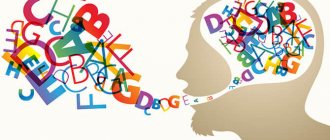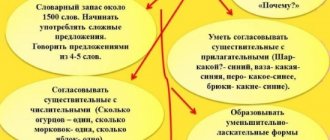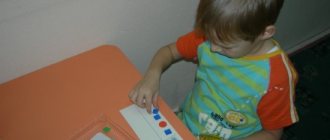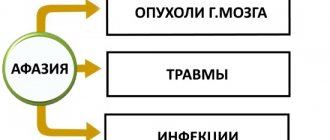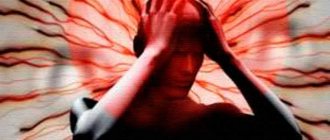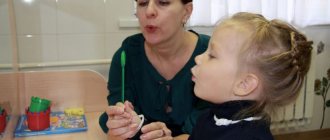Semantic aphasia is a complex speech pathology associated with impaired comprehension of logical-grammatical structures. Occurs when the parieto-temporo-occipital region (TPO zone) of the left hemisphere is damaged.
With this type of aphasia, a person experiences difficulties understanding the semantics of linguistic units, especially in the context of complex grammatical structures, suffers from a disorder of visual and spatial thinking, acalculia and elements of apraxia.
A syndrome characterized by a gradual loss of the ability to speak, read, write, and understand what others say is classified as primary progressive or semantic aphasia.
What is semantic aphasia
People with semantic aphasia have great difficulty understanding the meaning of words, finding names, or naming living and nonliving objects. Over time, people with semantic aphasia begin to use more general names for specific things.
For example, they may say "animal" instead of "dog." As their understanding of words deteriorates, they may eventually become unable to understand the speech of others.
Semantic aphasia as a separate type of aphasia was first described by the English aphasiologist Henry Head. He proposed a psycholinguistic classification of aphasias.
Subsequently, the scientist’s neuropsychological concept was developed by other researchers, including being reflected in the works of the Soviet psycholinguist A. R. Luria, who gave a more detailed description of this pathology.
It represents a cognitive disorder: there is no understanding of the semantics of the lexeme in the context of logical-grammatical language constructions.
Causes
- acute disorders of the blood supply to the brain (hemorrhagic stroke, ischemic stroke, subarachnoid hemorrhage, etc.);
- cancerous tumors of the brain and other organs that metastasize to the brain;
- TBI; damage to the cerebral cortex during neurosurgery;
- diseases of the brain (meningitis, meningoencephalitis), as well as brain abscesses of various etiologies (syphilis, tuberculosis, viral, bacterial, fungal infections);
- neurological diseases of a degenerative nature (for example, Parkinson's disease).
Speech apparatus device
The speech apparatus is a complex mechanism that represents the interaction of many organs and structures to produce speech. It consists of peripheral and central sections.
The peripheral speech apparatus includes several sections that act synergistically and provide sound reproduction. These include the respiratory organs, vocal folds, teeth, lips, tongue, palate, lower jaw and others.
The central speech apparatus is located in the brain. It is a complex system of interaction of neurons that allows a person not to think every second about the spoken phrases.
The key role in speech formation is played by the frontal, temporal and parietal lobes, mainly in the left hemisphere.
Interesting! Broca's area is located in the frontal gyri and is the center of the formation of one's own oral speech. Wernicke's center is located in the temporal lobe, which is the speech-auditory center and perceives incoming sound stimuli.
Pathogenesis
The above factors cause damage to certain areas of the brain (21st, 37th, 39th, 40th, 52nd Brodmann fields), which are included in the block of perceptual communication processes: acceptance, comprehension and storage of surface information. These fields combine multimodal information.
With semantic aphasia, the understanding of the basic, primary meaning of a word, associated with its sound shell, remains unchanged. Violations are present in the perception of secondary, figurative or homonymous meaning, the semantics of a word in the context of a phrase or sentence.
Problems arise with the perception of addressed speech, a violation of spatial perception, constructive apraxia, amnesia, which consists in difficulties in selecting the lexemes necessary for the statement.
Classification
Semantic aphasia has three stages:
- Easy. The consistent connection between phenomena is disrupted, and errors occur in distinguishing cause and effect. Difficulties arise in the contextual selection of a particular word and the interpretation of complex speech structures. There are difficulties in solving logic problems.
- Medium-heavy. There are difficulties in understanding grammatical constructions and allegorical phrases, and in performing arithmetic operations.
- Heavy. Characterized by pronounced disorders of visual-spatial perception. Understanding grammatical phrases and prepositional structures is significantly difficult or inaccessible.
Since this disorder primarily affects the temporal lobe of the brain, this process can be called irreversible.
Most often, semantic aphasia is observed in people aged 50-60 years and can last for 12 years. Although these figures are approximate and may deviate in one direction or another.
Often, in addition to speech disorders, behavioral deviations appear. Unfortunately, there are no medications to cure this condition yet. There are medications that can improve the condition and help retain certain moments from life in memory. However, no one can give a more favorable prognosis.
Research has shown that exercise helps improve brain health and improves mood and overall fitness. Eating a balanced diet, getting enough sleep and limiting alcohol consumption are other important ways to promote good brain health.
Other diseases that affect the brain, such as diabetes, high blood pressure and high cholesterol, should also be treated if present.
Children will return to normal faster
You should not demand excellent performance in school from your child immediately after overcoming the illness. Even after complete restoration of communication skills, a patient with aphasia may find it difficult to assimilate new information.
The good news is this: in acoustic-mnestic aphasia, the central mechanism does not destroy the brain of young people as significantly as in older people. With an integrated approach that combines drug treatment with physical exercise and other types of restorative therapies, the period of complete recovery is on average five years. However, among young patients in good health, cases of accelerated and sudden relief from the disease are sometimes observed. In addition, in adults, recovery usually remains partial, but in children there is a high chance of full recovery of brain function.
When to sound the alarm?
It is necessary to sound the alarm and conduct a thorough diagnostic examination when observing the following three indicators if:
There is a gradual deterioration of language (not just speech). The language problem is initially the only deficiency. The main cause is a neurodegenerative disease.
A distinctive feature of the semantic variant of aphasia is the progressive loss of word meanings. If there are additional severe problems in identifying objects or persons, the condition is also called semantic dementia.
Other language skills, including the ability to produce speech and repeat phrases and sentences spoken by others, are not affected. However, although the affected person may continue to speak freely, their speech becomes unclear and difficult to understand because many words are omitted or replaced.
Language problems increase over time. There is a slow but progressive loss of vocabulary and the ability to understand what people say. Speech becomes increasingly vague and the amount of speech tends to decrease.
In the future, non-linguistic functions are disrupted during the disease. In particular, a person may find it increasingly difficult to recognize familiar people or household objects. Problems associated with carrying out normal daily activities are also increasing.
Prevention and prognosis for patients
Restoring the victim’s speech depends on a whole range of factors, the most important of which are:
- Localization and volume of affected brain tissue;
- Level of speech disorder;
- Time from the start of rehabilitation after injury or vascular lesion;
- The age of the victim and his general condition.
The best results are expected to be observed in younger people, however, do not be discouraged, since the reactivity of compensatory-restorative reserves is developed differently in each person and with intensive rehabilitation it can be significantly activated.
Prevention mainly consists of preventing the occurrence of repeated or recurrent episodes of the disease that provokes the development of aphasia. For this purpose, it is necessary to undergo timely and regular diagnostic examinations and correct even minor deviations from the norm. Patients who have already encountered clinically pronounced forms of aphasia and have undergone rehabilitation should still be periodically observed by neurologists or neurosurgeons.
How to recognize?
By a number of signs you can find out that a person is beginning or progressing in the form of aphasia we are considering.
Anomie
Inability to remember the names of objects; the difficulty of “finding the right word.” The affected person may not be able to name the picture of the truck or may substitute another word in the same category, such as “car” instead of “truck.”
Abbreviated understanding of one word
The affected person cannot remember what words mean, especially words that are less familiar or used less frequently. For example, he might ask “What is a truck?”
When the patient is asked to bring an orange, he may return with an apple because the meaning of the word "orange" has been lost. This does not mean that the object is not recognized, as evidenced by the fact that the patient will not attempt to eat an orange without peeling it.
Forgetting familiar objects
Inability to remember what a familiar object is or how it is used. For example, the victim may be unable to identify common kitchen utensils and how they are used in food preparation. This is very unusual in the initial stages of semantic aphasia, but may appear later.
Surface dyslexia/dysgraphia
Difficulty reading and writing words that do not follow the rules of pronunciation or spelling; such words are written or pronounced “as if” they were following rules.
Dyslexic speech disorders
Specialists
Aphasia is a neurological disease, which means that this pathology is treated by a specialist - a neurologist. Aphasia is treated either in multidisciplinary municipal hospitals in neurological departments, or in specialized centers. One of the most progressive and largest neurological centers is the Clinical Brain Institute. The clinic has a polyclinic, day and 24-hour hospitals that provide prevention, treatment and rehabilitation of patients with a wide variety of neurological pathologies. A speech restoration center operates on the basis of the rehabilitation block. It is in this center that patients who have suffered traumatic brain injuries, acute cerebrovascular accident and suffering from various forms of aphasia undergo treatment and correction.
In addition to the neurologist, a rehabilitation specialist, psychotherapist and speech therapist must take part in the treatment of patients with aphasia.
Symptoms of semantic aphasia
- Phrasal speech is expressive, normal in volume and speed, but consists of simple sentences.
- Characteristic are grammatical errors regarding the agreement of words and the use of the desired case form. A person understands the meaning of simple syntactic structures and individual words. Common or complex sentences are difficult to understand.
- It is difficult to perceive isolated phrases, inserted structures, complex and compound sentences.
- Sayings, proverbs, metaphors, phraseological units and other set expressions are perceived not in a figurative, but in a literal meaning (for example, what goes around comes around; they count chickens in the fall; happy people don’t watch the clock; sit in a puddle, put spokes in the wheels, make molehills).
- The understanding of the part-speech division of linguistic units is impaired. Noun names patients classify running, dawn, and departure as verbs, and the verbs turn green and blush as adjectives; adjectives that become nouns (canteen, ice cream, bakery) are considered adjectives.
- Due to a violation of understanding the grammatical category of a word, the patient cannot understand and fulfill requests of this type: touch his head with a ruler, show a glass with a pencil.
- The understanding of prepositional-case constructions is impaired due to spatial agnosia (under the table, above the head, on the table, in the nightstand), forms of comparison (faster, slower; more, higher, lower), word forms of R.p. (mother’s coat, friend’s car), revolutions with a temporary value (after spring, on the eve of a holiday).
- The perception of time and space is disrupted. A person cannot fulfill a simple request: to arrange objects in a certain way (for example, put a pencil on the right side of the eraser and to the left of the book; put a notebook in the middle of the table).
- Calculation develops due to difficulties in performing sequential arithmetic operations. There are problems understanding ordinal numbers.
- There are violations in the lexico-grammatical development of the statement. The patient also forgets the names of some objects when creating a sentence. In such cases, the use of descriptive phrases is often observed (what they write with; what they drink from), or words with categorical meaning (this is such a fruit, such furniture), the building of associative connections can be traced as a way of replacing the main word (yellow, shines in the sky )
- Written speech, just like oral speech, contains only uncomplicated syntactic structures, and manifestations of agraphia can be observed.
- The ability to read and understand what is read is preserved, but only simple texts written without the use of complex, long sentences are available for full perception and comprehension. Reading fiction is most often not conscious.
Diagnostics
To diagnose the disease, various methods are used, including: magnetic resonance imaging, computed tomography, cerebral hemodynamics study, cerebrospinal fluid analysis, transcranial Doppler ultrasound (USD), duplex scanning. Anamnesis data is analyzed (presence of head injury, tumors, stroke, etc.).
Consultation with a neurologist and speech therapist is required.
In cases where semantic aphasia is not clearly expressed, the determination of speech disorders is possible only by performing specially selected tasks and exercises aimed at identifying certain disorders.
When making a diagnosis, it is important to differentiate semantic aphasia from other speech disorders. Unlike dysarthria, articulatory ability is preserved. Semantic aphasia differs from acoustic types of aphasia in the preservation of phonemic hearing and auditory-verbal memory. With dynamic aphasia, speech becomes non-expressive, stereotypical statements are observed, which does not happen with semantic aphasia.
Expressive speech
Motor or expressive speech is the pronunciation of individual sounds by the person himself. Broca's center, located in the frontal gyri, is responsible for this type.
When the frontal region is affected, the patient loses the ability to pronounce words and produces only inarticulate sounds. At the same time, he understands speech addressed to him and can respond to it with gestures or movements.
Interesting! When Broca's area is damaged, persistent speech impairments are observed, but it can be restored. Damage to Wernicke's center leads to irreversible speech disorders.
Treatment of semantic aphasia
Drug therapy with nootropic and vasoactive drugs should be carried out simultaneously with speech therapy correction and rehabilitation measures.
Rehabilitation work is carried out by a neurologist, speech therapist, and neuropsychologist. Treatment must be comprehensive.
Speech therapy correction includes:
- restoration of visual-spatial thinking (the patient is offered various exercises: completing a figure or missing parts of the picture, assembling a puzzle, arranging objects in accordance with the task);
- restoration of semantic perception (analysis of grammatical word forms, cognates, polysemantic words and homonyms and their use, differentiation of participial and participial phrases, selection of synonyms and antonyms, interpretation of set expressions and metaphors is carried out);
- restoration of arithmetic abilities (with the easy form, logical problems are solved (for example: Kolya is taller than Petya, but shorter than Vasya. Which of the boys is taller than all? Below all?); with the medium form, the stages of solving complex mathematical expressions are analyzed; with the severe form, they achieve the ability to solve elementary examples of addition and subtraction).
What is the prognosis for people with semantic aphasia?
The success of treatment depends on the cause, characteristics of the manifestation and course of the disease, as well as the effectiveness of medical actions and prescriptions.
Of no small importance are the patient’s age, his awareness of the severity of the disease, and his desire to be treated. In some cases, the patient does not see any problems and, accordingly, refuses medical help.
With timely speech therapy treatment and non-severe forms of the disease, the prognosis is favorable: all speech functions are restored. Severe disorders require longer treatment. In this case, complete restoration of all speech norms may not occur.
Prevention of the disease consists of preventing various brain lesions: injuries, cerebrovascular pathology, infectious and oncological diseases.
This is a difficult question to answer as there has been very little research in this area and it can be extremely variable from person to person. However, we know that from the onset of symptoms, many people will live more than 10 years, maybe more than 15 years.
Speech and language therapists and researchers evaluate the ability of people with aphasia to understand single words. They usually rely on tests that require the person with aphasia to listen to, or read, a word and then point to the corresponding picture.
These tests may not be a good measure of people's true abilities, however, because they involve much more than just the meaning of the word.
Additionally, this type of assessment typically only tests word comprehension for tangible objects, such as a pen or apple, and does not test words for abstract concepts, such as love or chance, which are also often used in everyday conversation.
Happening
An 81-year-old woman presented to the hospital emergency department complaining of difficulty reading. The woman read books and newspapers every day. She had a complete higher education.
The day before her admission, she woke up in the morning noticing that the letters of any texts she tried to read were “jumbled,” making it very difficult for her to read. Since there were no other neurological problems and her vision was said to be unaffected (no visual symptoms were detected), she decided to wait until the next day to seek help.
At the emergency department, her blood pressure was 140/90 mm Hg, heart rate 90 beats per minute, normal cardiac and pulmonary auscultation, and absent cervical processes.
On neurological examination:
she was attentive and oriented, with preserved fluency and repetition, without paraphases; she had difficulty naming common objects (she could name a pen, not a watch, but could tell the purpose of each object) and remember the name of her son accompanying her, and she could not name the names of her daughter or her 5 grandchildren, although she knew who they were ; long-term memory was not impaired; was presented with severe difficulty in reading simple texts as well as writing, including her own name; finger agnosia and left-sided disorientation were not noted; constructive praxis and calculus were spared; right-sided homonymous hemianopia was observed, and there was no motor deficit.
An electrocardiogram revealed sinus rhythm with nonspecific changes in ventricular repolarization. Computed tomography of the brain revealed a left posterior temporo-parieto-occipital infarction, which included the angular gyrus and excluded the inferior temporal gyrus.
Magnetic resonance imaging of the brain confirmed the same results.
The patient was then admitted to the intensive care unit and started taking acetylsalicylic acid at a dose of 300 mg per day along with statin therapy.
During the hospital stay, additional antihypertensive drugs were prescribed.
No significant echocardiographic abnormalities were detected, but Doppler examination revealed minor abnormalities of the carotid arteries due to the presence of atherosclerotic plaques; Together with brain imaging and clinical findings, these findings suggested a possible atherothrombotic etiology of stroke, but there was no obstruction greater than 50% in the cervical arteries.
She was still making some semantic errors when she was discharged home a few days later.
Semantic aphasia is also known as anomalous aphasia due to the naming impairment that is a characteristic feature of this form of language disorder.
Our patient had semantic aphasia, leading to difficulties in reading (Alexia) and writing (agraphia), as well as homonymous hemianopsia, which was verified only during a neurological examination, as a result of which a diagnosis of acute ischemic stroke was made.
The classic components of Gerstmann's syndrome were not observed, but involvement of the left angular gyrus and its contiguity could likely explain the signs and symptoms we encountered.
Since the lesion size was considered large 9 (more than 1.5 cm on any plane), the prognosis may not be as good for language performance, but serial evaluation should be further conducted to assess evolution.
The left angular gyrus integrates functions from several other brain regions. This may account for left-to-right orientation, constructive practice, naming, reading and writing (spatial representation of words), numbering, and finger recognition.
We now know that most of these functions are distributed across neural networks with parallel processing and are not localized to a specific brain region, but an incomplete form of spatial representation impairment can be found in patients with injuries to or near the angular gyrus.
Unfortunately, our patient was unable to receive treatment because it took her more than 24 hours to seek neurological care.
From Visual Imagery to Storytelling
Correction of communication skills can be started only after the root cause of the disease has been eliminated. Remedial training for acoustic-mnestic aphasia is based on classes with a speech therapist aimed at expanding speech and auditory memory. In acoustic-mnestic aphasia, the mechanism is blocked the easier the earlier treatment is started. The speech therapist can come into the patient’s room even before he begins to get out of bed.
The Center for Pediatric Speech Neurology and Rehabilitation "Neurospectr" returns speech to patients through:
- working with visual images;
- restoration of situationally conditioned speech;
- remembering factual information;
- independent development of plots.
First, patients are shown images with labeled names of objects, while simultaneously explaining the functions and scope of the object.
At the second stage of recovery, the child is given verbal instructions that he must follow to maintain dialogue.
Finally, children are asked to solve crosswords and riddles, remember addresses, dates and names. They are told short stories and read passages from books, and then asked to retell them in as much detail as possible. In the final phase, the child independently composes stories based on the proposed plots or shown pictures.
Acoustic-mnestic aphasia leads to memory impairment due to insufficient blood supply to the brain. To activate blood flow, patients are prescribed neurometabolic drugs and neuroprotectors. Specialists at our center note that due to the high plasticity of the child’s brain, it is enough to overcome the acute period of the disease - and speech restoration will proceed extremely quickly.
